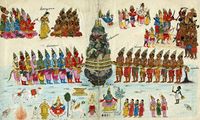On the Origin of Species: Turtwig, Grotle and Torterra
|
There's a story about a famous scientist – some sources say it was Bertrand Russell, others that it was William James – giving a public lecture on astronomy. He described to the audience how the Earth orbits the Sun, and how the Sun, in turn, orbits the center of the galaxy. At the end, he was approached by an old lady. "Everything that you've told us is rubbish," she said. "The world is actually a flat plate on the back of a giant turtle." The scientist, deciding to humor her, responded: "And what does this turtle stand on?" "Ah," said the old woman. "The turtle stands on the back of another, far larger turtle." "In that case," the scientist countered, "what does the second turtle stand on?" "It's no use trying to argue," the old woman replied. "It's turtles all the way down!"
This story is much loved by scientists, in part because it's a good illustration of the problem of infinite regress, a type of logical fallacy where the proposed solution to a problem itself requires a similar solution, and so on to infinity. But it's of interest to us because it illustrates the pervasiveness of an ancient myth upon which a family of Pokémon is based.
Turtwig, Grotle and Torterra are all inspired by the concept of the World Turtle: a giant turtle that supports (or in some versions contains) the world. This idea is expressed – albeit in miniature form – in the development of the Turtwig family. Turtwig has a single sprout growing out of its head, Grotle has a forest on its back, and Torterra seems to support a whole mini-ecosystem. As the family grows, there is an increasing resemblance to various types of armored dinosaur, but the primary inspiration is still the humble turtle.
The World Turtle myth is most commonly thought of as Hindu, but it actually appears in numerous cultures around the world. In Hinduism, the turtle in question is Kurma, the second avatar of Vishnu, who supported a mountain on his back. An alternative interpretation of Kurma has the world existing inside him: the ground is his lower shell, the atmosphere is his body and the heavens are his upper shell. This may be tied in with the mythology of ancient China, which viewed the world in a similar way: a flat earth and a domed sky.
Indeed, there is a Chinese version of this myth, although it differs significantly from the Hindu versions. In it, the water god Gong Gong (共工) has a fight with Zhu Rong (祝融), the god of fire, in an effort to secure the throne of Heaven. He loses, and in a fit of anger, headbutts a nearby mountain. Said mountain was, unfortunately, holding up the sky, and as the mountain crumbles, the sky begins to tilt to the north-west, and the land to the south-east, triggering immense floods and other natural disasters. Catastrophe was averted by the intervention of the benevolent goddess Nüwa (女娲). She cut the legs off a giant sea turtle and used them to replace the destroyed mountain, propping up the sky once more. Some of the damage was irreversible, however, and this incident is supposedly to blame for the fact that the sun, moon and planets seem to move to the north-west, and that most rivers in China flow to the south-east.
You might be surprised to learn that the version of this myth that most closely resembles the Turtwig family comes not from Asia at all, but from America. The creation myth of the Lenape, sometimes known as the Delaware Indians, describes a giant turtle emerging from the sea. The Creator placed mud on top of the turtle's shell, and a great tree grew from it. Sprouts of the tree became the first man and woman, and thus, the world was created. The turtle was considered to be a metaphor for life itself, displaying perseverance and longevity. This particular creation myth doesn't seem to be limited to the Lenape, and is said to be shared by many other tribes of the Northeastern Woodlands, including the Iroquois.
It's in this last telling of the story that we see most of the qualities associated with Turtwig and its evolutions. Perhaps most crucially, this is the only version in which a tree is central to the myth – the gradual growth of a tree being a very important aspect of Turtwig's design, and presumably also the reason for its Grass typing.
We'll return to Hindu mythology for a moment to discuss a related concept, the World Elephant. In various traditions, the world is said to be supported on the backs of a number of elephants. Over time, the notions of the World Turtle and World Elephants have been conflated (primarily, it would seem, by Western observers) to produce a version of the story in which the world rests on the backs of elephants, who are, in turn, supported by a giant turtle. It's important to mention this because it relates to one of the most well-known popular adaptations of the World Turtle myth.
In Terry Pratchett's long-running Discworld series, the world comprises a mostly-flat disc supported by four giant elephants, which stand on the back of Great A'Tuin, enormous turtle that swims through space. The books give the star turtle's species as Chelys galactica, and jokingly refer to it as "the only turtle ever to feature on the Hertzsprung-Russel diagram". Though Great A'Tuin rarely features prominently in the books, it is an ever-present aspect of the series, and perhaps one of its most recognizable hallmarks.
The idea of a turtle holding up or otherwise supporting the world is compelling enough that it seems to have developed independently at least twice in cultures around the world. While Pokémon that take their inspiration from mythology usually (and quite understandably) reference Japanese folklore, this is one Pokémon family whose origins are truly international.

